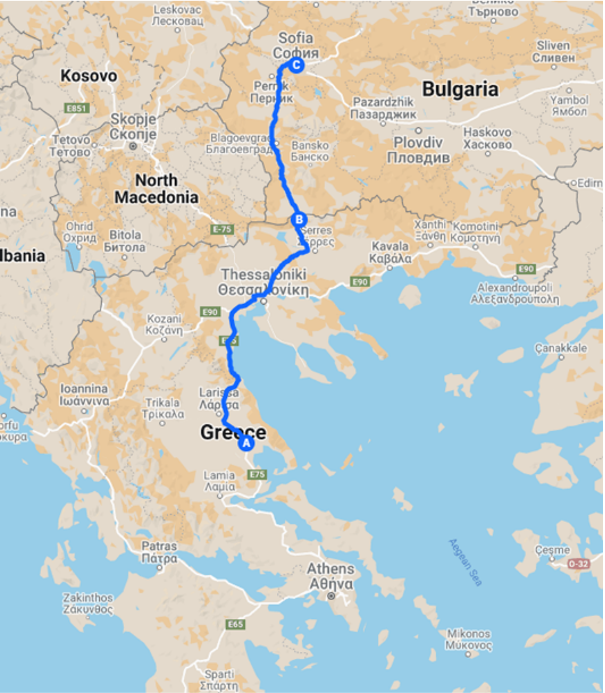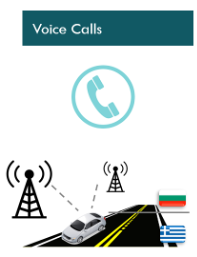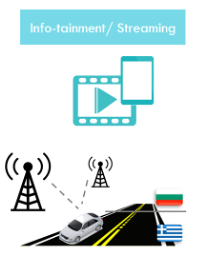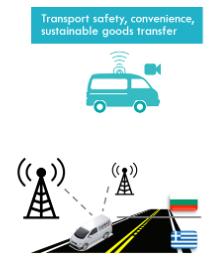Objectives
Objectives
Provide uninterrupted 5G connectivity, based on 3GPP Rel.16 SA, capable of supporting select advanced CAM UCs, focusing on the Orient/East-Med corridor traversing the GR-BG borders, including the border-crossing of Promahonas/Kulata.
Support the effective interconnection of the COSMOTE and A1BG PLMNs (Public Land Mobile Network) and investigate the optimal roaming configurations to support CAM traffic.
Validate the network (and applications) performance and the usefulness of 5G connectivity for automotive traffic via field trials targeting 5G AA use cases.
Deliver a thorough Business and Techno-economic analysis regarding cross border and national highway corridor 5G deployments.
 The 5G Seamless Roaming for the Greece-Bulgaria Cross-Border Corridor (5G SEAGUL) project will target the deployment and upgrade of 5G RAN, Core and transport elements along the Greek and Bulgarian highways of the Orient / East-Med (OEM) TEN-T corridor, in order to support Connected and Automated Mobility (CAM) services along the GR-BG border crossing area. More specifically, approximately 300 Km of highway on the Greek (GR) side and 173 Km of highway on the Bulgarian (BG) side will be covered with uninterrupted 5G connectivity adhering to the 3GPP Rel. 16 Stand Alone standards, using two pioneer bands, namely the 700 MHz and the 3.5 GHz.
The 5G Seamless Roaming for the Greece-Bulgaria Cross-Border Corridor (5G SEAGUL) project will target the deployment and upgrade of 5G RAN, Core and transport elements along the Greek and Bulgarian highways of the Orient / East-Med (OEM) TEN-T corridor, in order to support Connected and Automated Mobility (CAM) services along the GR-BG border crossing area. More specifically, approximately 300 Km of highway on the Greek (GR) side and 173 Km of highway on the Bulgarian (BG) side will be covered with uninterrupted 5G connectivity adhering to the 3GPP Rel. 16 Stand Alone standards, using two pioneer bands, namely the 700 MHz and the 3.5 GHz.
The 5G SEAGUL project has a strong cross-border orientation, as the area on both GR and BG sides will be extensively covered by both bands, while special focus activities will be undertaken for the optimum network interconnection and roaming / handover configuration. The seamless handover experienced by connected vehicles will be measured and validated via real-life cross-border trials. The project plans to use the CEF2 co-funding scheme to speed up the deployment and upgrade of 5G connectivity along the GR and BG highways by 2025, in otherwise de-prioritised areas for 5G deployment, and thus enabling more efficient, smart, sustainable and environmentally friendly mobility along one of the major EU transport paths. By doing so, the project will actively contribute towards the achievement of the CEF2 programme, the EU Gigabit Society Strategy and the EU Sustainable and Smart Mobility Strategy objectives. 5G SEAGUL has a work-plan spanning 36 months, to deliver full operational and validated 5G networks by the end of 2025, while real-life CAM UCs will be validated based on the requirements set forth by 5GAA, using 5G enabled On-Board Units (OBUs) owned by WINGS.
5G SEAGUL Use cases
Use Case 1: Basic Services: Uninterrupted Packet-Switched Voice Calls
 This use case considers providing uninterrupted Voice over LTE (VoLTE) calls along the corridors in scope, within A1BG and COSMOTE networks, as well as during crossing Bulgaria – Greece national border in Kulata – Promachonas region. The use case is part of the 5GAA scenarios that will offer customers seamless voice service, with no interruptions during the handover between VPLMNs, e.g., during autonomous driving mode
This use case considers providing uninterrupted Voice over LTE (VoLTE) calls along the corridors in scope, within A1BG and COSMOTE networks, as well as during crossing Bulgaria – Greece national border in Kulata – Promachonas region. The use case is part of the 5GAA scenarios that will offer customers seamless voice service, with no interruptions during the handover between VPLMNs, e.g., during autonomous driving mode
Use Case 2: Basic Services: Uninterrupted Video Calls
 This use case is implementation of basic data call service and considers providing uninterrupted video calls along the corridors in scope, within A1BG and COSMOTE networks, as well as during crossing Bulgaria – Greece national border in Kulata – Promachonas region. The use case is part of the 5GAA scenarios that will offer customers seamless data service, with no interruptions during the handover between VPLMNs, e.g., during autonomous driving mode.
This use case is implementation of basic data call service and considers providing uninterrupted video calls along the corridors in scope, within A1BG and COSMOTE networks, as well as during crossing Bulgaria – Greece national border in Kulata – Promachonas region. The use case is part of the 5GAA scenarios that will offer customers seamless data service, with no interruptions during the handover between VPLMNs, e.g., during autonomous driving mode.
Use Case 3: Convenience: Infotainment Uninterrupted Video Streaming
 This use case is implementation of basic data call service and considers providing uninterrupted streaming video calls along the corridors in scope, within A1BG and COSMOTE networks, as well as during crossing Bulgaria – Greece national border in Kulata – Promachonas region. The use case is part of the 5GAA scenarios that will offer customers seamless data service, with no interruptions during the handover between VPLMNs, e.g., during autonomous driving mode.
This use case is implementation of basic data call service and considers providing uninterrupted streaming video calls along the corridors in scope, within A1BG and COSMOTE networks, as well as during crossing Bulgaria – Greece national border in Kulata – Promachonas region. The use case is part of the 5GAA scenarios that will offer customers seamless data service, with no interruptions during the handover between VPLMNs, e.g., during autonomous driving mode.
Use Case 4 Safety: Data Sharing for Real-time Situation Awareness and Traffic Information
 This use case considers data sharing between the vehicles and an application server for the purpose of local situation awareness and traffic information notifications, a foreseen priority for the road operators. This use case builds upon the concepts described in the 5GAA use cases Safety: Traffic Jam Warning & Route Information and Real-Time Situational Awareness; Automated Driving: Data Sharing of Dynamic Objects focusing on the exchange of any information available or generated by the vehicle, vehicle’s sensors and cameras with a traffic management application.
This use case considers data sharing between the vehicles and an application server for the purpose of local situation awareness and traffic information notifications, a foreseen priority for the road operators. This use case builds upon the concepts described in the 5GAA use cases Safety: Traffic Jam Warning & Route Information and Real-Time Situational Awareness; Automated Driving: Data Sharing of Dynamic Objects focusing on the exchange of any information available or generated by the vehicle, vehicle’s sensors and cameras with a traffic management application.
Use Case 5: Transport safety, convenience, sustainable goods transfer
 This use case considers vehicle on-boards sensors which transmit over 5G various data related to the driver, the road, the vehicle, and the freight (in the case that the vehicle transports goods). This use case refers to Vehicle Operations Management, Safety, Convenience cases of 5GAA. According to the use case’s scope, vehicle on-boards sensors transmit over 5G the data collected, together with its GPS position to a management application server which then proceeds with respective notifications and alerts. Overall, the goals and expected outcomes of integrating 5G technology into logistics transport with a focus on safety, convenience, and sustainable goods transfer include improved safety, enhanced convenience, sustainable operations, increased efficiency, and a competitive advantage in the market.
This use case considers vehicle on-boards sensors which transmit over 5G various data related to the driver, the road, the vehicle, and the freight (in the case that the vehicle transports goods). This use case refers to Vehicle Operations Management, Safety, Convenience cases of 5GAA. According to the use case’s scope, vehicle on-boards sensors transmit over 5G the data collected, together with its GPS position to a management application server which then proceeds with respective notifications and alerts. Overall, the goals and expected outcomes of integrating 5G technology into logistics transport with a focus on safety, convenience, and sustainable goods transfer include improved safety, enhanced convenience, sustainable operations, increased efficiency, and a competitive advantage in the market.
